The Agência de Transporte do Estado de São Paulo (ARTESP), which oversees public transportation for the State of São Paulo, Brazil, has opened its Information Control Centre, designed to help ensure the quality of service provided by local operators of the state's highways. The centre will unify traffic data, incident management and service delivery through the use of advanced analytics to help ensure safer and more efficient travel for a population of 20 million across 271 cities.
The new system, built on IBM Intelligent transportation technology as well as consulting expertise from IBM and IBM business partner Magna Sistemas, will be based in the state transportation agency's headquarters in São Paulo. The new centre will capture, link and unify data from operational control centres of each of the 19 highway administrators that operate nearly 30 state roads. IBM technologies will help the agency improve supervision of nearly 4,000 miles of state highways, something previously done only through physical inspections.
By using sophisticated big data analytics, IBM’s intelligent operations software allows transportation agency employees to gather better insights for smarter decision making to help diffuse transportation and traffic issues, while IBM Maximo software will be on hand to provide asset management throughout its highway network in São Paulo.
"The information control centre for the state will be able to oversee São Paulo´s highways in near real time. With IBM technology in place we will now have the right tools to check quality of services provided by each administrator and also the corresponding contract fulfilment,” said ARTESP general director, Karla Bertocco Trindade. “This kind of insightful data will add to the comfort and safety for our citizens and extend the quality of the highways in our state.”
"The push for a truly intelligent transportation system in São Paulo is an unprecedented project for Brazil,” said Eric-Mark Huitema, Global Smarter Transportation leader, IBM Smarter Cities. "Transportation departments everywhere are up against a deluge of data. ARTESP is using it to their advantage, engaging powerful analytics to glean insights from the terabytes upon terabytes of traffic data that will ultimately improve transportation for Brazilian citizens.”
São Paulo unifies traffic data and services
The Agência de Transporte do Estado de São Paulo (ARTESP), which oversees public transportation for the State of São Paulo, Brazil, has opened its Information Control Centre, designed to help ensure the quality of service provided by local operators of the state's highways. The centre will unify traffic data, incident management and service delivery through the use of advanced analytics to help ensure safer and more efficient travel for a population of 20 million across 271 cities.
The new system, built
September 9, 2014
Read time: 2 mins









